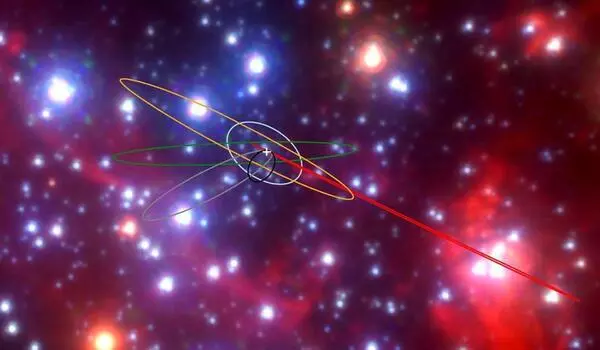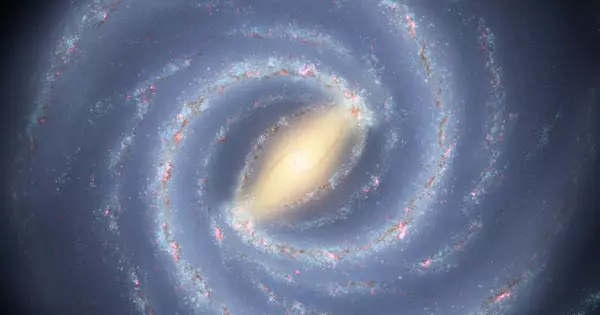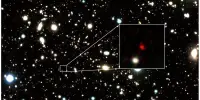The McDonald Observatory at The University of Texas at Austin has discovered an unusually massive black hole at the heart of Leo I, one of the Milky Way’s dwarf satellite galaxies. The discovery, which is almost as massive as our own galaxy’s black hole, could change our understanding of how all galaxies — the building blocks of the universe — evolve. The research was published in the most recent issue of The Astrophysical Journal.
Astronomers believe that nearly all galaxies, including our own, have these massive black holes at their centers, where light and matter cannot escape, making images of them extremely difficult. Gravity causes light to be chaotically bent and twisted around as it is sucked into the abyss along with superheated gas and dust.
The colorized image unveiled Thursday is from the international consortium behind the Event Horizon Telescope, a collection of eight synchronized radio telescopes around the world. Previous efforts had found the black hole in the center of our galaxy too jumpy to get a good picture.
Because of its uniqueness, the team decided to study Leo I. Leo I, unlike most dwarf galaxies orbiting the Milky Way, is devoid of dark matter. Researchers determined Leo I’s dark matter profile, or how the density of dark matter changes from the galaxy’s outskirts to its core. They accomplished this by calculating its gravitational pull on the stars: the faster the stars move, the more matter is contained in their orbits. The researchers were particularly interested in whether the density of dark matter increases toward the galaxy’s center. They also wanted to know if their profile measurement would be consistent with previous ones made using older telescope data and computer models.
The models scream that you need a black hole at the center; you don’t need a lot of dark matter. You have a very small galaxy collapsing into the Milky Way, and its black hole is roughly the same size as the Milky Way’s. The mass-to-volume ratio is enormous. The Milky Way is dominant, but the Leo I black hole is close.
María José Bustamante
Led by recent UT Austin doctoral graduate María José Bustamante, the team includes UT astronomers Eva Noyola, Karl Gebhardt and Greg Zeimann, as well as colleagues from Germany’s Max Planck Institute for Extraterrestrial Physics (MPE).
They used a unique instrument called VIRUS-W on McDonald Observatory’s 2.7-meter Harlan J. Smith Telescope for their observations. The team received a startling result after feeding their improved data and sophisticated models into a supercomputer at UT Austin’s Texas Advanced Computing Center.
“The models scream that you need a black hole at the center; you don’t need a lot of dark matter,” Gebhardt explained. “You have a very small galaxy collapsing into the Milky Way, and its black hole is roughly the same size as the Milky Way’s. The mass-to-volume ratio is enormous. The Milky Way is dominant, but the Leo I black hole is close.” The outcome is unprecedented.

The researchers said the result was different from the past studies of Leo I due to a combination of better data and the supercomputer simulations. The central, dense region of the galaxy was mostly unexplored in previous studies, which concentrated on the velocities of individual stars. The current study showed that for those few velocities that were taken in the past, there was a bias toward low velocities. This, in turn, decreased the inferred amount of matter enclosed within their orbits.
The new data is concentrated in the center and is not influenced by this bias. The amount of inferred matter contained within the stars’ orbits increased dramatically. The discovery could upend astronomers’ understanding of galaxy evolution because “there is no explanation for this kind of black hole in dwarf spheroidal galaxies,” according to Bustamante.
The discovery is all the more significant because astronomers have used galaxies like Leo I, known as “dwarf spheroidal galaxies,” for 20 years to study how dark matter is distributed within galaxies, according to Gebhardt. This new type of black hole merger also provides a new signal for gravitational wave observatories to look for.
“If the mass of Leo I’s black hole is large, it may explain how black holes grow in massive galaxies,” Gebhardt said. This is because, as small galaxies like Leo I collide with larger galaxies, the smaller galaxy’s black hole merges with that of the larger galaxy, increasing its mass.
VIRUS-W, developed by a team at MPE in Germany, is the only instrument in the world capable of performing this type of dark matter profile study. Noyola pointed out that many dwarf galaxies in the southern hemisphere are good targets for it, but no southern hemisphere telescope is equipped for it. However, the Giant Magellan Telescope (GMT) now under construction in Chile was designed in part for this type of work.















